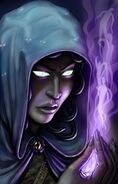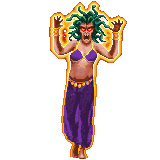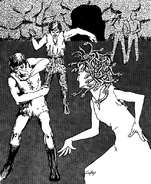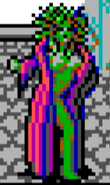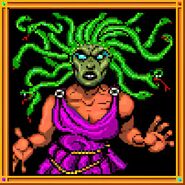Ir'revrykal (talk | contribs) m (→Gallery: replace file with promotional version) |
SunderedShor (talk | contribs) m (+1 app.) Tag: Source edit |
||
| (51 intermediate revisions by 13 users not shown) | |||
| Line 1: | Line 1: | ||
{{Creature |
{{Creature |
||
| − | | image = < |
+ | | image = <gallery> |
| + | medusa-5e.jpg|5e |
||
| − | 5e = [[File:Medusa-5e.png|250px]]|-| |
||
| − | + | Medusa 4e.jpg|4e |
|
| − | + | MM35_PG181.jpg|3e |
|
| − | + | Medusa.png|2e |
|
| − | + | Medusa1.jpg|1e |
|
| − | </ |
+ | </gallery> |
| + | | caption2 = Various depictions of medusae. |
||
| ⚫ | |||
| name = Medusa |
| name = Medusa |
||
| + | | othernames = |
||
| size5e = Medium |
| size5e = Medium |
||
| type5e = [[Monstrosity]] |
| type5e = [[Monstrosity]] |
||
| Line 15: | Line 16: | ||
| challenge5e = 6 |
| challenge5e = 6 |
||
| refs5e = <ref name="MM5e-p214">{{Cite book/Monster Manual 5th edition|214}}</ref> |
| refs5e = <ref name="MM5e-p214">{{Cite book/Monster Manual 5th edition|214}}</ref> |
||
| − | | size4e = |
+ | | size4e = Medium |
| − | | origin4e = |
+ | | origin4e = [[Natural creatures|Natural]] |
| type4e = [[Humanoid]] |
| type4e = [[Humanoid]] |
||
| subtype4e = |
| subtype4e = |
||
| − | | alignment4e = |
+ | | alignment4e = [[Evil]] |
| − | | refs4e = <ref name="MM4e-p186">{{Cite book/Monster Manual 4th edition|186}}</ref> |
+ | | refs4e = <ref name="MM4e-p186-187">{{Cite book/Monster Manual 4th edition|186-187}}</ref> |
| size3e = Medium |
| size3e = Medium |
||
| type3e = [[Monstrous humanoid]] |
| type3e = [[Monstrous humanoid]] |
||
| Line 29: | Line 30: | ||
| size2e = Medium |
| size2e = Medium |
||
| alignment2e = [[Lawful evil]] |
| alignment2e = [[Lawful evil]] |
||
| − | | refs2e = <ref name="MCVO-90">{{Cite book/Monstrous Compendium Volume One|90}}</ref> |
+ | | refs2e = <ref name="MCVO-90">{{Cite book/Monstrous Compendium Volume One|90}}</ref><ref name="MM2e-p247">{{Cite book/Monstrous Manual|247}}</ref> |
| size1e = Medium |
| size1e = Medium |
||
| alignment1e = [[Lawful evil]] |
| alignment1e = [[Lawful evil]] |
||
| refs1e = <ref name="MM1-p66">{{Cite book/Monster Manual 1st edition|66}}</ref> |
| refs1e = <ref name="MM1-p66">{{Cite book/Monster Manual 1st edition|66}}</ref> |
||
| patron deity = |
| patron deity = |
||
| + | | movement = |
||
| vision = [[Darkvision]]<ref name="MM5e-p214" /><ref name="MM3.5-p180"/> |
| vision = [[Darkvision]]<ref name="MM5e-p214" /><ref name="MM3.5-p180"/> |
||
| ⚫ | |||
| + | | diet = Omnivore<ref name="MM2e-p247" /> |
||
| lifespan = |
| lifespan = |
||
| location = |
| location = |
||
| − | | language = [[Common]]<ref name="MM5e-p214" /><ref name="MM4e-p186"/><ref name="MM3.5-p180"/> |
+ | | language = [[Common]]<ref name="MM5e-p214" /><ref name="MM4e-p186-187" /><ref name="MM3.5-p180"/> |
| − | | subraces = [[Maedar]]<ref name="MM-p248">{{Cite book/Monstrous Manual|248}}</ref> |
+ | | subraces = [[Greater medusa]]<ref name="MM2e-p247" /><br />[[Maedar]]<ref name="MM-p248">{{Cite book/Monstrous Manual|248}}</ref> |
| climate = Temperate<ref name="MM3.5-p180"/> |
| climate = Temperate<ref name="MM3.5-p180"/> |
||
| terrain = Marshes<ref name="MM3.5-p180"/> |
| terrain = Marshes<ref name="MM3.5-p180"/> |
||
| ⚫ | |||
| − | | height = 5' (1.5 m) – 6' (1.8 m)<ref name="MM3.5-p180"/><ref name="MM-p247">{{Cite book/Monstrous Manual|247}}</ref> |
||
| + | | height = {{SIrange|5|6|ft}} |
||
| length = |
| length = |
||
| wingspan = |
| wingspan = |
||
| weight = |
| weight = |
||
| − | | skincolor = |
+ | | skincolor = Pale, earthy |
| − | | haircolor = |
+ | | haircolor = |
| + | | hairstyles = A writhing mass of {{SIAdj|1|ft|c|adj=long}} serpents |
||
| ⚫ | |||
| feathers = |
| feathers = |
||
| + | | eyecolor = Red |
||
| + | | build = |
||
| distinctions = |
| distinctions = |
||
| + | | appearrefs = <ref name="MM3.5-p180"/><ref name="MM2e-p247" /> |
||
| ⚫ | |||
| − | | first = [[Dungeons & Dragons (1974) |
+ | | first = [[Dungeons & Dragons (1974)|''Dungeons & Dragons'' (1974)]] |
| ⚫ | |||
| + | | histrefs = <ref name="ODD-p10">{{Cite book/Dungeons & Dragons (1974)/Monsters & Treasure|10}}</ref> |
||
}} |
}} |
||
| + | A '''medusa''' ({{Plural|medusae|refs=<ref name="MM2e-p247" /><ref name="ODD-p10" /><ref name="EE-SGM2e-p28-30">{{Cite book/Elminster's Ecologies/The Stonelands and the Goblin Marches|28-30}}</ref>}} {{Plural|medusas|alt=yes|refs=<ref name="MM5e-p214" /><ref name="MM4e-p186-187" /><ref name="MM3.5-p180" />}}) was a monstrous and hateful creature that was capable of [[petrification|petrifying]] any creature that met its gaze.<ref name="MM3.5-p180" /><ref name="MM2e-p247" /> |
||
| − | '''Medusae''' were monstrous beings with bodies that are covered in scales and rather than hair, they had a writhing mass of serpents growing from their scalp.<ref name="MM3.5-p180" /> |
||
| + | |||
| + | ==Description== |
||
| + | Typical medusae had scaly skins of either pale<ref name="MM2e-p247" /> or earthy color.<ref name="MM3.5-p180" /> Their eyes glowed with an intense red color and, instead of hair, their heads were covered in a mass of {{SIAdj|1|ft|c|adj=long}} living venomous serpents. Despite those features, from large distances they could easily be mistaken by ordinary [[human]]s.<ref name="MM3.5-p180"/><ref name="MM2e-p247" /> For that reason, it was common for medusae to hide their features behind hoods or veils.<ref name="MM3.5-p180" /> |
||
| + | |||
| + | People cursed into becoming medusae could belong to either sex<ref name="MM5e-p214" /> and both male and female medusae created by such curses were similar in form and capabilities.<ref name="PotA5e-p199">{{Cite book/Princes of the Apocalypse|199}}</ref> |
||
| + | |||
| + | ===Variants=== |
||
| + | An uncommon variant of medusa known as a [[greater medusa]] had the lower torso of a snake and its entire body covered by thin scales, with a total body length of {{SI|20|ft|long=yes}}. They produced considerably more potent poison, which rendered even their skins harmful to the touch. They also used their innate poison to coat their weapons and arrows.<ref name="MM2e-p247" /> |
||
| + | |||
| + | In the [[Utter East]], variants of medusae similar to greater medusae were sometimes referred to as "gorgons" (not to be confused with the [[gorgon|iron-skinned bulls]] of the same name). While their look could petrify a living creature, it was reported that the effect was usually temporary. They lurked within the ruins of [[Phantom Pass]] and [[Old Stone Keep]] and in the [[Puzzle Palace]].<ref name="B&M">{{Cite game/Blood & Magic}}</ref><ref group="note">''Blood & Magic'''s artwork and terminology do not closely match typical D&D monsters. The Gorgon unit is a neutral enemy unit. While it takes after the D&D medusa in key respects, its name is taken from [[Wikipedia:Gorgon|the mythological gorgon]].</ref> |
||
| + | |||
| + | An extremely rare variant of male medusa was known as a [[maedar]], which lacked the head serpents and the petrifying gaze of regular medusae, but possessed great physical strength<ref name="MM2e-p248" /> and in some cases a poisonous weakening gaze.<ref name="MM4e-p186-187" /> |
||
| + | |||
| + | ==Personality== |
||
| + | Most medusae despised their own powers and viewed their abilities as a curse. They directed their frustration and anger outwards, seeking to petrify any living creature they encountered, and only used restraint when hunting prey for food or when searching for a mate.<ref name="EE-SGM2e-p28-30" /> |
||
==Abilities== |
==Abilities== |
||
| + | [[File:Medusa archer.jpg|thumb|250px|left|''A medusa with a petrified victim.'']] |
||
| − | The eyes of a medusa were feared, because to look in their eyes was to invite death. A female's gaze would instantly transform living flesh into lifeless stone, while a male's gaze would daze and weaken.<ref name="MM4e-p186" /> |
||
| + | The glowing red eyes of a medusa were feared for their petrifying power. Anyone within a range of {{SI|30|ft|long=yes}} of a medusa who looked at its eyes could be transformed into lifeless stone within seconds, at the medusa's discretion. It was possible to resist that power through extraordinary physical resilience,<ref name="MM5e-p214" /><ref name="MM4e-p186-187" /><ref name="MM3.5-p180"/> or by averting one's eyes from the medusa's.<ref name="MM5e-p214" /><ref name="MM3.5-p180"/><ref name="MM2e-p248" /> The petrification was permanent, unless reversed with magic such as a ''[[greater restoration]]'' [[spell]] or similar.<ref name="MM5e-p214" /><ref name="MM2e-p248" /> |
||
| + | |||
| + | A medusa's vision and petrifying gaze also reached into the [[Ethereal plane|Ethereal]] and the [[Astral Plane]].<ref name="MM2e-p247" /> In the Border Ethereal, as a result of the plane's obscuring nature,<ref name="GEP2e-p10">{{Cite book/A Guide to the Ethereal Plane|10}}</ref> the creature's features could only be recognized at dangerously close distances: its bright red eyes could only be seen from {{SI|30|ft|long=yes}} or less, while the serpents were only visible from a distance of less than {{SI|12|ft|long=yes}}. Although a medusa's gaze affected creatures in the Ethereal, its head snakes and physical attacks had no effect on ethereal targets.<ref name="GEP2e-p59">{{Cite book/A Guide to the Ethereal Plane|59}}</ref> |
||
| + | |||
| + | A medusa was immune to the petrifying stare of other medusae,<ref name="MM2e-p247" /> but was susceptible to be turned into stone by its own gaze, for example when looking at its own reflection in a [[mirror]] or other reflective surface.<ref name="MM5e-p214" /><ref name="MM2e-p247" /> Even after death, a medusa's eyes retained their power for several days, becoming weaker as the corpse decayed.<ref name="MM2e-p247" /> |
||
| + | |||
| + | ==Combat== |
||
| + | A medusa's typical strategy was to lure potential victims within the {{SIAdj|30|ft}} range of its gaze and then induce them into looking in its eyes. If the victims managed to avert their eyes in time, the medusa followed up with powerful attacks from its head serpents, whose [[venom]] was potent enough to severely poison or even kill a creature. If none of those strategies succeeded, medusae were also competent with a number of weapons, such as [[knife|knives]], [[short sword]]s [[shortbow]]s, and [[longbow]]s.<ref name="MM5e-p214" /><ref name="MM2e-p247" /> Many medusae were considered skilled archers and some greater medusae were known to coat arrows with their [[poison]]ous saliva or blood.<ref name="MM4e-p186-187" /><ref name="MM2e-p247" /> |
||
==Society== |
==Society== |
||
| + | Medusae prefered to live alone or in small groups, but they desired treasures and dominance over other [[humanoid]] societies. It was common for a group of medusae to seek to rule a rural community as a reclusive royal family, or for a lone medusa to become a crime lord or the leader of an assassin's guild. They were typically seen in the company of creatures who were immune to their gaze, such as [[grimlock]]s and [[gargoyle]]s, though they were also known to gather humanoid servants.<ref name="MM4e-p186-187" /> Medusae and maedar formed monogamous relationships and usually mated for life,<ref name="MM2e-p248" /><ref name="EE-SGM2e-p28-30" /> forming a powerful emotional bond that bordered on obsession.<ref name="EE-SGM2e-p28-30" /> |
||
| − | Medusae prefered to live alone in small groups, but they desired treasures and dominance over other races most of all.<ref name="MM4e-p187">{{Cite book/Monster Manual 4th edition|187}}</ref> |
||
| + | |||
| + | Medusae typically made their homes in dark caves or large abandoned structures. Their lairs progressively fell into a state of disrepair, riddled with shadowy overgrowth, hiding places, and obstacles, usually inhabited by nests of venomous serpents. While they enjoyed keeping the petrified statues of their victims as trophies or decoration for their lairs, some medusae also destroyed most of their victims' remains in order to make their lairs less immediately recognizable by wary adventurers.<ref name="MM5e-p214" /><ref name="MM2e-p248" /> |
||
| + | |||
| + | It was common for medusae to associate with equally powerful or stronger creatures. In particular, medusae held [[yuan-ti]] in high regard, so small groups of medusae and maedar often allied with them to work together.<ref name="MM4e-p186-187" /> |
||
| + | |||
| + | As a result of their ability to perceive and influence the Ethereal Plane, a few medusae made their home in the Border Ethereal.<ref name="MotP1e-p14,16">{{Cite book/Manual of the Planes 1st edition|14,16}}</ref> The gaze from an ethereal medusa could just as easily petrify a victim in the [[Prime Material plane]], which made them terrifying opponents.<ref name="GEP2e-p59" /> [[Earth (element)|Earth]] [[half-elemental]] medusae were also known to inhabit the caves of the [[Elemental Plane of Earth]].<ref name="MotP3e-p73">{{Cite book/Manual of the Planes 3rd edition|73}}</ref><ref name="IP2e-p36">{{Cite book/The Inner Planes|36}}</ref> |
||
| + | |||
| + | A few powerful medusae also made their home in [[Olympus]] and elsewhere in the [[Arvandor (layer)|first layer]] of [[Arborea]],<ref name="TOP2e-p63">{{Cite book/Tales of the Outer Planes|63}}</ref><ref name="OHG2e-p117">{{Cite book/On Hallowed Ground|117}}</ref><ref name="PC-BC2e-p40">{{Template:Cite book/Planes of Chaos/The Book of Chaos|40}}</ref> as well as in [[Ysgard]].<ref name="MotP1e-p93,95">{{Cite book/Manual of the Planes 1st edition|93,95}}</ref> In the [[Lower planes]], [[half-fiend]]ish medusae could also be found in the [[Abyss]] and the [[Nine Hells]].<ref name="MotP3e-p149,151">{{Cite book/Manual of the Planes 3rd edition|149,151}}</ref> |
||
| + | |||
| + | ===Religion=== |
||
| + | Medusae respected the [[Titan]] [[Skoraeus Stonebones]], but they did not worship him.<ref name=Dr#106-p17>{{Cite dragon/106/The Ecology of the Maedar|17}}</ref> Rather, religious medusae worshiped the [[naga]] [[deity]] [[Shekinester]], who they called '''Shekenster'''.<ref>{{cite dragon/296/Worshipers of the Forbidden|50}}</ref> The [[yuan-ti]] god [[Sseth]] was known to favor medusae and maedar, often working through them.<ref name="PP2e-p86">{{Cite book/Powers & Pantheons|86}}</ref> |
||
| + | |||
| + | ==Ecology== |
||
| + | [[File:marlos-5e.jpg|thumb|250px|''[[Marlos Urnrayle]], a male medusa.'']] |
||
| + | ===Physiology=== |
||
| + | Medusae ate sparingly and had small appetites. Mated couples of medusae and maedar usually fed by the use of the maedar's ability to turn broken fragments of petrified victims back into flesh.<ref name="EE-SGM2e-p28-30" /> Among vegetable sources of food, medusae were particularly fond of [[shrieker]]s and other fungi.<ref name="EE-SL2e-p25-26">{{Cite book/Elminster's Ecologies/The Settled Lands|25-26}}</ref> |
||
| + | |||
| + | ===Reproduction=== |
||
| + | Medusae could reproduce by mating amongst themselves and with other humanoids. If mating with a human, a female medusa produced a clutch of between two and six eggs that always hatched into female medusae. The fate of a human after mating with a medusa was usually death by petrification.<ref name="MM2e-p247" /> |
||
| + | |||
| + | If a medusa and a maedar mated, the eggs produced human offspring in 99% of the cases, in which case the babies were immediately petrified upon seeing their mother. In only 1% of the cases, a maedar was born.<ref name="MM2e-p247" /><ref name="MM2e-p248">{{Cite book/Monstrous Manual|248}}</ref> |
||
| + | |||
| + | Medusae laid their eggs within one month of mating, and the eggs had an incubation period of eight months. Young medusa hatchlings resembled human baby girls with green stubby tendrils growing from their heads, which came alive as serpents once they reached two years of age. Young medusae matured at the same rate as humans, and acquired the ability to petrify others upon reaching adolescence.<ref name="MM2e-p247" /> |
||
| + | |||
| + | ===Uses=== |
||
| + | The blood of medusae had special properties that allowed it to reverse the process of petrification. In order for it to work, the blood needed to be applied to the petrified creature's mouth or lips by a skilled healer. It could only reverse the condition if the victim had been petrified within 24 hours.<ref name="MM4e-p186-187" /> Medusa blood could also be used to craft ''[[potion of human control|potions of human control]]'' and ''[[potion of mammal control|potions of mammal control]]''. Older medusae were capable of brewing [[potion]]s that could restore petrified creatures, which they traded amongst themselves and employed to restore petrified creatures by accident.<ref name="EE-SGM2e-p28-30" /> |
||
| + | |||
| + | The venom from a medusa's snakes was renowned among assassins for its potency.<ref name="EE-SGM2e-p28-30" /> It was one of the required [[material component]]s to scribe a [[scroll]] of ''[[protection from petrification]]''. Each scroll required {{SI|1|fl scruple|ml|variant=apot|long=yes}} of venom, in addition to other ingredients.<ref name="DMG1e-p117">{{Cite book/Dungeon Masters Guide 1st edition|117}}</ref> A medusa's eyes could also be used as an ingredient for the scroll.<ref name="EE-SGM2e-p28-30" /> |
||
| + | |||
| + | The head snakes themselves could be harvested to produce ''[[potion of reptile control|potions of reptile control]]''. However, they were rarely harvested due to the horrible stench that emanated from them after death.<ref name="EE-SL2e-p25-26" /> |
||
| + | |||
| + | The stone from petrified corpses of medusae victims, when pulverized, could be used as a material component for spells that contacted denizens of other [[plane]]s. This practice, however, tended to be restricted to evil [[priest]]s,<ref name="EE-SL2e-p25-26" /> but [[Zhentarim]] agents were sometimes known to collect them for use in their spells.<ref name="VGC2e-p125">{{Cite book/Volo's Guide to Cormyr|125}}</ref> |
||
| + | |||
| + | ==History== |
||
| + | [[File:Medusa 2e.jpg|thumb|''A medusa armed with a [[dagger]].'']] |
||
| + | Some vain mortals could strike bargains with powerful [[fiend]]s such as [[archdevil]]s and [[demon lord]]s, offering everything in exchange for the gift of long-lasting beauty, power, and the admiration of others. Upon the expiration of the splendorous years bargained for, the price was collected and the mortals were turned into medusae.<ref name="MM5e-p214" /> |
||
| + | |||
| + | In the mid‒14{{th}} century [[DR]], members the [[Zhentarim]] were rumored to pursue an alliance with medusae and maedar of the [[Goblin Marches]] and the [[Stonelands]], offering treasure in exchange for recruiting them as agents of the Black Network. They conducted negotiations while under the protection of an unknown [[spell]] that purportedly protected them from the medusae's gaze.<ref name="EE-SGM2e-p28-30" /> |
||
| + | |||
| + | Around the same time, the inhabitants of [[Minroe]] developed a defense against a colony of medusae that lurked in a system of nearby caves, which were the source of prized [[pixie cap mushroom]]s that the inhabitants gathered and sold at high prices. The Minrovan farmers domesticated a variety of [[hedgehog shrieker]] that had developed a natural defense against medusae and only reacted to their presence. The citizens planted shrieker gardens around town to protect themselves from attacks, while gatherers carried them in carts when entering the caves.<ref name="EE-SL2e-p25-26" /><ref name="VGC2e-p125" /> |
||
| + | |||
| + | A group of three medusae inhabited the [[Sargauth Level]] of [[Undermountain]] in the mid‒14{{th}} century DR,<ref name="RU-CGU2e-p96">{{Cite book/The Ruins of Undermountain/Campaign Guide to Undermountain|96}}</ref> but they had been defeated by adventurers by the late 15{{th}} century.<ref name="WDMM5e-p50">{{Cite book/Waterdeep: Dungeon of the Mad Mage|50}}</ref> By then, another group of two medusae inhabited the [[Caverns of Ooze]], much deeper down the complex.<ref name="WDMM5e-p249">{{Cite book/Waterdeep: Dungeon of the Mad Mage|249}}</ref> |
||
| + | |||
| + | ==Notable Medusae== |
||
| + | * [[Marlos Urnrayle]], the leader of the [[Cult of the Black Earth]] in the late 15{{th}} century [[DR]].<ref name="PotA5e-p199" /> |
||
| + | * [[Neheedra Duskryn]], a former [[drow]] priestess of [[Lolth]] from [[Blingdenstone]] in the late 15{{th}} century DR.<ref name="OotA5e-p107">{{Cite book/Out of the Abyss|107}}</ref> |
||
| + | * [[Yashar]], a [[sorcerer]] who guarded the [[Undying Temple]] in the 14{{th}} century DR.<ref name="CSQ3e-p9">{{Cite book/City of the Spider Queen|9}}</ref> |
||
| + | * [[Zalkoré]], an [[Omu]]an queen who was transformed into a medusa by an [[erinyes]] and subsequently lost her sanity.<ref name="ToA5e-p74,79">{{Cite book/Tomb of Annihilation|74,79}}</ref> |
||
==Appendix== |
==Appendix== |
||
| + | ===Notes=== |
||
| − | {{Incomplete}} |
||
| + | {{Notes}} |
||
| + | |||
| ⚫ | |||
| + | {{Appearances |
||
| + | |adventures = ''[[Tales of the Outer Planes]]'';{{Duapp|40|Khamsa's Folly}};''[[Undermountain: Maddgoth's Castle]]'';''[[The Dungeon of Death (adventure)|The Dungeon of Death]]'';[[Forgotten Realms Campaign Setting 3rd edition/Green Bones|''Green Bones'']];{{Duapp|128|Vampires of Waterdeep: The Fireplace Level}};''[[City of the Spider Queen]]'';''[[Anauroch: The Empire of Shade]]'';''[[Ghosts of Dragonspear Castle]]'';''[[Princes of the Apocalypse]]'';''[[Out of the Abyss]]'';''[[Tomb of Annihilation]]'';''[[Waterdeep: Dungeon of the Mad Mage]]'';{{Anthapp|Candlekeep Mysteries|The Curious Tale of Wisteria Vale}};{{Anthapp|Candlekeep Mysteries|The Price of Beauty}} |
||
| + | |adventure refs = ''[[Hordes of Dragonspear]]'' |
||
| + | |novels = ''[[The Spectral Blaze]]'';''[[The Last Threshold]]'' |
||
| + | |novel refs = ''[[Daughter of the Drow]]'';''[[The Council of Blades]]'';''[[Dangerous Games]]'' |
||
| + | |video games = {{PRapp|PR|CAB|SSB|PD}};''[[Eye of the Beholder II: The Legend of Darkmoon]]'';''[[Gateway to the Savage Frontier]]'';[[Neverwinter Nights (AOL game)|''Neverwinter Nights'' (AOL game)]];''[[Dungeon Hack]]'';''[[Blood & Magic]]'';''[[Planescape: Torment]]'';{{NWNapp|NWN|SoU}};''[[Neverwinter (game)|Neverwinter]]'';''[[Baldur's Gate: Siege of Dragonspear]]'' |
||
| + | |video game refs = ''[[Icewind Dale: Heart of Winter]]'' |
||
| + | |gamebooks = ''[[Knight of the Living Dead]]'' |
||
| + | |board games = ''[[Betrayal at Baldur's Gate]]'' |
||
| + | |card games = ''[[AD&D Trading Cards]]'';{{MTGapp|AFC}} |
||
| + | |organized play = ''[[Mayhem in the Earthspur Mines]]'';''[[The Ark of the Mountains]]'';''[[Last Orders at the Yawning Portal]]'' |
||
| + | |organized play refs = ''[[A Handful of Dust]]'';''[[In Volo's Wake]]'';''[[In Scarlet Flames]]'' |
||
| + | }} |
||
| + | |||
===Gallery=== |
===Gallery=== |
||
<gallery> |
<gallery> |
||
| − | + | Medusa spawn.png|''A medusa and her spawn.'' |
|
| + | Medusa sorceress NWN.jpg|''A medusa [[sorceress]].'' |
||
| + | Advance Euryale.png|''A medusa from 3DO's ''[[Wikipedia:Advanced Dungeons & Dragons: Slayer|Advanced Dungeons & Dragons: Slayer]]'' (1995).'' |
||
| + | Gorgon B&M.jpg|''A gorgon of the Utter East.'' |
||
| + | Medusa Petrification-1e.png|''A group of adventurers suffer the petrifying gaze of a medusa.'' |
||
| ⚫ | |||
| ⚫ | |||
| + | Vorpal sword Caio Monteiro.jpg|''A beheaded medusa.'' |
||
</gallery> |
</gallery> |
||
| − | |||
| ⚫ | |||
| − | ;Adventures: |
||
| − | * ''[[City of the Spider Queen]]'' |
||
| − | *''[[Dungeon magazine 40|Khamsa's Folly]]'' |
||
| − | * ''[[The Dungeon of Death (adventure)|The Dungeon of Death]]'' |
||
| − | ;Computer Games: |
||
| − | * ''[[Baldur's Gate: Siege of Dragonspear]]'' |
||
| − | * ''[[Curse of the Azure Bonds (game)|Curse of the Azure Bonds]]'' |
||
| − | * ''[[Eye of the Beholder II: The Legend of Darkmoon]]'' |
||
| ⚫ | |||
| − | * ''[[Neverwinter (game)|Neverwinter]]'' |
||
| − | * ''[[Neverwinter Nights]]'' |
||
| − | * ''[[Neverwinter Nights: Shadows of Undrentide]]'' |
||
| − | * ''[[Pools of Darkness (game)|Pools of Darkness]]'' |
||
| − | * ''[[Pool of Radiance (game)|Pool of Radiance]]'' |
||
| ⚫ | |||
===External Links=== |
===External Links=== |
||
| + | {{External link disclaimer}} |
||
* {{EW}} |
* {{EW}} |
||
| + | * {{Wikipedia_external_link}} |
||
===References=== |
===References=== |
||
{{Refs}} |
{{Refs}} |
||
| − | [[Category: |
+ | [[Category:Creatures found in the Ethereal Plane]] |
| − | [[Category: |
+ | [[Category:Creatures found in the Elemental Plane of Earth]] |
| − | [[Category: |
+ | [[Category:Creatures found in Olympus]] |
| − | [[Category:Creatures |
+ | [[Category:Creatures found in Arvandor (layer)]] |
| − | [[Category:Creatures]] |
+ | [[Category:Creatures found in Arborea]] |
| + | [[Category:Creatures found in Ysgard]] |
||
| + | [[Category:Creatures found in the Abyss]] |
||
| + | [[Category:Creatures found in the Nine Hells]] |
||
| + | [[Category:Good article nominees]] |
||
Latest revision as of 19:01, 23 December 2023
A medusa (pl: medusae[5][8][9] or: medusas[1][2][3]) was a monstrous and hateful creature that was capable of petrifying any creature that met its gaze.[3][5]
Description[]
Typical medusae had scaly skins of either pale[5] or earthy color.[3] Their eyes glowed with an intense red color and, instead of hair, their heads were covered in a mass of 1‑foot-long (30‑centimeter) living venomous serpents. Despite those features, from large distances they could easily be mistaken by ordinary humans.[3][5] For that reason, it was common for medusae to hide their features behind hoods or veils.[3]
People cursed into becoming medusae could belong to either sex[1] and both male and female medusae created by such curses were similar in form and capabilities.[10]
Variants[]
An uncommon variant of medusa known as a greater medusa had the lower torso of a snake and its entire body covered by thin scales, with a total body length of 20 feet (6.1 meters). They produced considerably more potent poison, which rendered even their skins harmful to the touch. They also used their innate poison to coat their weapons and arrows.[5]
In the Utter East, variants of medusae similar to greater medusae were sometimes referred to as "gorgons" (not to be confused with the iron-skinned bulls of the same name). While their look could petrify a living creature, it was reported that the effect was usually temporary. They lurked within the ruins of Phantom Pass and Old Stone Keep and in the Puzzle Palace.[11][note 1]
An extremely rare variant of male medusa was known as a maedar, which lacked the head serpents and the petrifying gaze of regular medusae, but possessed great physical strength[12] and in some cases a poisonous weakening gaze.[2]
Personality[]
Most medusae despised their own powers and viewed their abilities as a curse. They directed their frustration and anger outwards, seeking to petrify any living creature they encountered, and only used restraint when hunting prey for food or when searching for a mate.[9]
Abilities[]
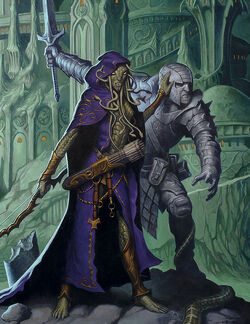
A medusa with a petrified victim.
The glowing red eyes of a medusa were feared for their petrifying power. Anyone within a range of 30 feet (9.1 meters) of a medusa who looked at its eyes could be transformed into lifeless stone within seconds, at the medusa's discretion. It was possible to resist that power through extraordinary physical resilience,[1][2][3] or by averting one's eyes from the medusa's.[1][3][12] The petrification was permanent, unless reversed with magic such as a greater restoration spell or similar.[1][12]
A medusa's vision and petrifying gaze also reached into the Ethereal and the Astral Plane.[5] In the Border Ethereal, as a result of the plane's obscuring nature,[13] the creature's features could only be recognized at dangerously close distances: its bright red eyes could only be seen from 30 feet (9.1 meters) or less, while the serpents were only visible from a distance of less than 12 feet (3.7 meters). Although a medusa's gaze affected creatures in the Ethereal, its head snakes and physical attacks had no effect on ethereal targets.[14]
A medusa was immune to the petrifying stare of other medusae,[5] but was susceptible to be turned into stone by its own gaze, for example when looking at its own reflection in a mirror or other reflective surface.[1][5] Even after death, a medusa's eyes retained their power for several days, becoming weaker as the corpse decayed.[5]
Combat[]
A medusa's typical strategy was to lure potential victims within the 30‑foot (9.1‑meter) range of its gaze and then induce them into looking in its eyes. If the victims managed to avert their eyes in time, the medusa followed up with powerful attacks from its head serpents, whose venom was potent enough to severely poison or even kill a creature. If none of those strategies succeeded, medusae were also competent with a number of weapons, such as knives, short swords shortbows, and longbows.[1][5] Many medusae were considered skilled archers and some greater medusae were known to coat arrows with their poisonous saliva or blood.[2][5]
Society[]
Medusae prefered to live alone or in small groups, but they desired treasures and dominance over other humanoid societies. It was common for a group of medusae to seek to rule a rural community as a reclusive royal family, or for a lone medusa to become a crime lord or the leader of an assassin's guild. They were typically seen in the company of creatures who were immune to their gaze, such as grimlocks and gargoyles, though they were also known to gather humanoid servants.[2] Medusae and maedar formed monogamous relationships and usually mated for life,[12][9] forming a powerful emotional bond that bordered on obsession.[9]
Medusae typically made their homes in dark caves or large abandoned structures. Their lairs progressively fell into a state of disrepair, riddled with shadowy overgrowth, hiding places, and obstacles, usually inhabited by nests of venomous serpents. While they enjoyed keeping the petrified statues of their victims as trophies or decoration for their lairs, some medusae also destroyed most of their victims' remains in order to make their lairs less immediately recognizable by wary adventurers.[1][12]
It was common for medusae to associate with equally powerful or stronger creatures. In particular, medusae held yuan-ti in high regard, so small groups of medusae and maedar often allied with them to work together.[2]
As a result of their ability to perceive and influence the Ethereal Plane, a few medusae made their home in the Border Ethereal.[15] The gaze from an ethereal medusa could just as easily petrify a victim in the Prime Material plane, which made them terrifying opponents.[14] Earth half-elemental medusae were also known to inhabit the caves of the Elemental Plane of Earth.[16][17]
A few powerful medusae also made their home in Olympus and elsewhere in the first layer of Arborea,[18][19][20] as well as in Ysgard.[21] In the Lower planes, half-fiendish medusae could also be found in the Abyss and the Nine Hells.[22]
Religion[]
Medusae respected the Titan Skoraeus Stonebones, but they did not worship him.[23] Rather, religious medusae worshiped the naga deity Shekinester, who they called Shekenster.[24] The yuan-ti god Sseth was known to favor medusae and maedar, often working through them.[25]
Ecology[]
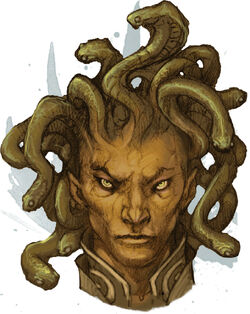
Marlos Urnrayle, a male medusa.
Physiology[]
Medusae ate sparingly and had small appetites. Mated couples of medusae and maedar usually fed by the use of the maedar's ability to turn broken fragments of petrified victims back into flesh.[9] Among vegetable sources of food, medusae were particularly fond of shriekers and other fungi.[26]
Reproduction[]
Medusae could reproduce by mating amongst themselves and with other humanoids. If mating with a human, a female medusa produced a clutch of between two and six eggs that always hatched into female medusae. The fate of a human after mating with a medusa was usually death by petrification.[5]
If a medusa and a maedar mated, the eggs produced human offspring in 99% of the cases, in which case the babies were immediately petrified upon seeing their mother. In only 1% of the cases, a maedar was born.[5][12]
Medusae laid their eggs within one month of mating, and the eggs had an incubation period of eight months. Young medusa hatchlings resembled human baby girls with green stubby tendrils growing from their heads, which came alive as serpents once they reached two years of age. Young medusae matured at the same rate as humans, and acquired the ability to petrify others upon reaching adolescence.[5]
Uses[]
The blood of medusae had special properties that allowed it to reverse the process of petrification. In order for it to work, the blood needed to be applied to the petrified creature's mouth or lips by a skilled healer. It could only reverse the condition if the victim had been petrified within 24 hours.[2] Medusa blood could also be used to craft potions of human control and potions of mammal control. Older medusae were capable of brewing potions that could restore petrified creatures, which they traded amongst themselves and employed to restore petrified creatures by accident.[9]
The venom from a medusa's snakes was renowned among assassins for its potency.[9] It was one of the required material components to scribe a scroll of protection from petrification. Each scroll required 1 fluid scruple (1.2 milliliters) of venom, in addition to other ingredients.[27] A medusa's eyes could also be used as an ingredient for the scroll.[9]
The head snakes themselves could be harvested to produce potions of reptile control. However, they were rarely harvested due to the horrible stench that emanated from them after death.[26]
The stone from petrified corpses of medusae victims, when pulverized, could be used as a material component for spells that contacted denizens of other planes. This practice, however, tended to be restricted to evil priests,[26] but Zhentarim agents were sometimes known to collect them for use in their spells.[28]
History[]
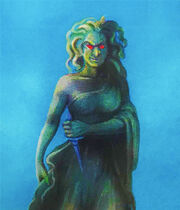
A medusa armed with a dagger.
Some vain mortals could strike bargains with powerful fiends such as archdevils and demon lords, offering everything in exchange for the gift of long-lasting beauty, power, and the admiration of others. Upon the expiration of the splendorous years bargained for, the price was collected and the mortals were turned into medusae.[1]
In the mid‒14th century DR, members the Zhentarim were rumored to pursue an alliance with medusae and maedar of the Goblin Marches and the Stonelands, offering treasure in exchange for recruiting them as agents of the Black Network. They conducted negotiations while under the protection of an unknown spell that purportedly protected them from the medusae's gaze.[9]
Around the same time, the inhabitants of Minroe developed a defense against a colony of medusae that lurked in a system of nearby caves, which were the source of prized pixie cap mushrooms that the inhabitants gathered and sold at high prices. The Minrovan farmers domesticated a variety of hedgehog shrieker that had developed a natural defense against medusae and only reacted to their presence. The citizens planted shrieker gardens around town to protect themselves from attacks, while gatherers carried them in carts when entering the caves.[26][28]
A group of three medusae inhabited the Sargauth Level of Undermountain in the mid‒14th century DR,[29] but they had been defeated by adventurers by the late 15th century.[30] By then, another group of two medusae inhabited the Caverns of Ooze, much deeper down the complex.[31]
Notable Medusae[]
- Marlos Urnrayle, the leader of the Cult of the Black Earth in the late 15th century DR.[10]
- Neheedra Duskryn, a former drow priestess of Lolth from Blingdenstone in the late 15th century DR.[32]
- Yashar, a sorcerer who guarded the Undying Temple in the 14th century DR.[33]
- Zalkoré, an Omuan queen who was transformed into a medusa by an erinyes and subsequently lost her sanity.[34]
Appendix[]
Notes[]
- ↑ Blood & Magic's artwork and terminology do not closely match typical D&D monsters. The Gorgon unit is a neutral enemy unit. While it takes after the D&D medusa in key respects, its name is taken from the mythological gorgon.
Appearances[]
Adventures
Hordes of Dragonspear
Novels & Short Stories
Gamebooks
Video Games
Icewind Dale: Heart of Winter
Board Games
Card Games
Organized Play & Licensed Adventures
Gallery[]
External Links[]
Disclaimer: The views expressed in the following links do not necessarily represent the views of the editors of this wiki, nor does any lore presented necessarily adhere to established canon.
 Medusa article at the Eberron Wiki, a wiki for the Eberron campaign setting.
Medusa article at the Eberron Wiki, a wiki for the Eberron campaign setting. Medusa article at Wikipedia, The Free Encyclopedia.
Medusa article at Wikipedia, The Free Encyclopedia.
References[]
- ↑ 1.00 1.01 1.02 1.03 1.04 1.05 1.06 1.07 1.08 1.09 1.10 1.11 Mike Mearls, Jeremy Crawford, Christopher Perkins (2014-09-30). Monster Manual 5th edition. Edited by Scott Fitzgerald Gray. (Wizards of the Coast), p. 214. ISBN 978-0786965614.
- ↑ 2.0 2.1 2.2 2.3 2.4 2.5 2.6 2.7 2.8 Mike Mearls, Stephen Schubert, James Wyatt (June 2008). Monster Manual 4th edition. (Wizards of the Coast), pp. 186–187. ISBN 978-0-7869-4852-9.
- ↑ 3.00 3.01 3.02 3.03 3.04 3.05 3.06 3.07 3.08 3.09 3.10 3.11 3.12 Skip Williams, Jonathan Tweet, Monte Cook (July 2003). Monster Manual v.3.5. (Wizards of the Coast), p. 180. ISBN 0-7869-2893-X.
- ↑ David "Zeb" Cook et al. (1989). Monstrous Compendium Volume One. (TSR, Inc), p. 90. ISBN 0-8803-8738-6.
- ↑ 5.00 5.01 5.02 5.03 5.04 5.05 5.06 5.07 5.08 5.09 5.10 5.11 5.12 5.13 5.14 5.15 5.16 5.17 5.18 Doug Stewart (June 1993). Monstrous Manual. (TSR, Inc), p. 247. ISBN 1-5607-6619-0.
- ↑ Gary Gygax (December 1977). Monster Manual, 1st edition. (TSR, Inc), p. 66. ISBN 0-935696-00-8.
- ↑ Doug Stewart (June 1993). Monstrous Manual. (TSR, Inc), p. 248. ISBN 1-5607-6619-0.
- ↑ 8.0 8.1 Gary Gygax, Dave Arneson (1974). “Monsters & Treasure”. Dungeons & Dragons (TSR, Inc), p. 10.
- ↑ 9.0 9.1 9.2 9.3 9.4 9.5 9.6 9.7 9.8 James Butler, Elizabeth T. Danforth, Jean Rabe (September 1994). “The Stonelands and the Goblin Marches”. In Karen S. Boomgarden ed. Elminster's Ecologies (TSR, Inc), pp. 28–30. ISBN 1-5607-6917-3.
- ↑ 10.0 10.1 Richard Baker, et al. (April 2015). Princes of the Apocalypse. Edited by Michele Carter, Stacy Janssen. (Wizards of the Coast), p. 199. ISBN 978-0-7869-6578-6.
- ↑ Tachyon Studios (November 1996). Designed by Brian Fargo. Blood & Magic. Interplay.
- ↑ 12.0 12.1 12.2 12.3 12.4 12.5 Doug Stewart (June 1993). Monstrous Manual. (TSR, Inc), p. 248. ISBN 1-5607-6619-0.
- ↑ Bruce R. Cordell (1998). A Guide to the Ethereal Plane. Edited by Michele Carter, Keith Francis Strohm. (TSR, Inc.), p. 10. ISBN 0-7869-1205-7.
- ↑ 14.0 14.1 Bruce R. Cordell (1998). A Guide to the Ethereal Plane. Edited by Michele Carter, Keith Francis Strohm. (TSR, Inc.), p. 59. ISBN 0-7869-1205-7.
- ↑ Jeff Grubb (July 1987). Manual of the Planes 1st edition. (TSR), pp. 14, 16. ISBN 0880383992.
- ↑ Jeff Grubb, Bruce R. Cordell, David Noonan (September 2001). Manual of the Planes 3rd edition. (Wizards of the Coast), p. 73. ISBN 0-7869-1850-8.
- ↑ Monte Cook and William W. Connors (December 7, 1998). The Inner Planes. Edited by Michele Carter and Ray Vallese. (TSR, Inc.), p. 36. ISBN 0-7869-0736-3.
- ↑ Gary L. Thomas ed. (May 1988). Tales of the Outer Planes. (TSR, Inc.), p. 63. ISBN 978-0880385442.
- ↑ Colin McComb (October 1996). On Hallowed Ground. Edited by Ray Vallese. (TSR, Inc.), p. 117. ISBN 0-7869-0430-5.
- ↑ Wolfgang Baur and Lester Smith (1994-07-01). “The Book of Chaos”. In Michele Carter ed. Planes of Chaos (TSR, Inc), p. 40. ISBN 1560768746.
- ↑ Jeff Grubb (July 1987). Manual of the Planes 1st edition. (TSR), pp. 93, 95. ISBN 0880383992.
- ↑ Jeff Grubb, Bruce R. Cordell, David Noonan (September 2001). Manual of the Planes 3rd edition. (Wizards of the Coast), pp. 149, 151. ISBN 0-7869-1850-8.
- ↑ Ed Greenwood (February 1986). “The Ecology of the Maedar”. In Kim Mohan ed. Dragon #106 (TSR, Inc.), p. 17.
- ↑ Eric Cagle (June 2002). “Worshipers of the Forbidden”. In Jesse Decker ed. Dragon #296 (Wizards of the Coast), p. 50.
- ↑ Eric L. Boyd (September 1997). Powers & Pantheons. Edited by Julia Martin. (TSR, Inc.), p. 86. ISBN 978-0786906574.
- ↑ 26.0 26.1 26.2 26.3 James Butler, Elizabeth T. Danforth, Jean Rabe (September 1994). “The Settled Lands”. In Karen S. Boomgarden ed. Elminster's Ecologies (TSR, Inc), pp. 25–26. ISBN 1-5607-6917-3.
- ↑ Gary Gygax (1979). Dungeon Masters Guide 1st edition. (TSR, Inc.), p. 117. ISBN 0-9356-9602-4.
- ↑ 28.0 28.1 Ed Greenwood (July 1995). Volo's Guide to Cormyr. (Wizards of the Coast), p. 125. ISBN 0-7869-0151-9.
- ↑ Ed Greenwood (1991). “Campaign Guide to Undermountain”. In Steven E. Schend ed. The Ruins of Undermountain (TSR, Inc.), p. 96. ISBN 1-5607-6061-3.
- ↑ Christopher Perkins (November 2018). Waterdeep: Dungeon of the Mad Mage. Edited by Jeremy Crawford. (Wizards of the Coast), p. 50. ISBN 978-0-7869-6626-4.
- ↑ Christopher Perkins (November 2018). Waterdeep: Dungeon of the Mad Mage. Edited by Jeremy Crawford. (Wizards of the Coast), p. 249. ISBN 978-0-7869-6626-4.
- ↑ Christopher Perkins, Adam Lee, Richard Whitters (September 1, 2015). Out of the Abyss. Edited by Jeremy Crawford. (Wizards of the Coast), p. 107. ISBN 978-0-7869-6581-6.
- ↑ James Wyatt (September 2002). City of the Spider Queen. (Wizards of the Coast), p. 9. ISBN 0-7869-1212-X.
- ↑ Christopher Perkins, Will Doyle, Steve Winter (September 19, 2017). Tomb of Annihilation. Edited by Michele Carter, Scott Fitzgerald Gray. (Wizards of the Coast), pp. 74, 79. ISBN 978-0-7869-6610-3.


